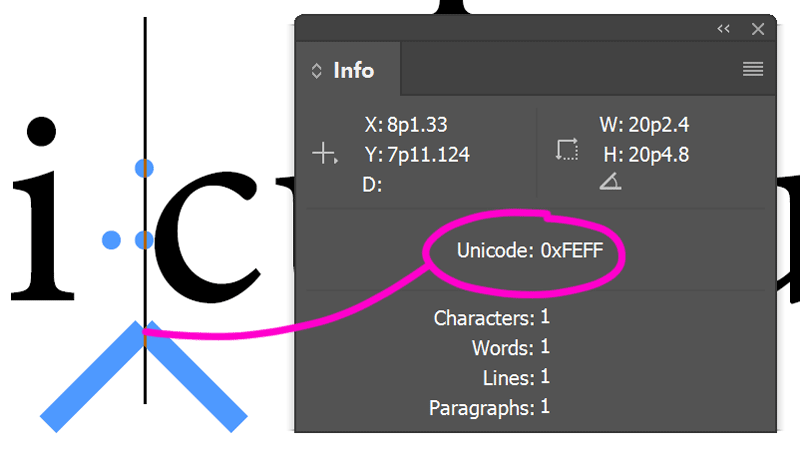Copy link to clipboard
Copied
Hi
I have to collect some paragraphs in script, colect them ina a new document and export in RTF format.
Some of paragraphs contain a graphics, wchich of course is lost during the procces (and that is good for me). But in their places a symbol : appears. When I copy this to Find/Change GREP window it is shown as ~I.
The problem is, that Find/Change can not find this thing. I can remove it using script but I don't know what is that. How to name it?
 1 Correct answer
1 Correct answer
@mateuszp13156491 said: "The problem is, that Find/Change can not find this thing."
Hm. My guess is that you see a FEFF special character. Check that by selecting the character and look up its Unicode code point with InDesign's Info panel. If it is the one you cannot find it with GREP Find, but you should be able to find and remove it with TEXT Find/Change. The find pattern would be:
<FEFF>But be careful with removing it. Here a screenshot that describes what that special character stands for
...Copy link to clipboard
Copied
That's odd. Usually, when using GREP, ~I represents an index marker. I would have expected an anchored object marker (that's ~a, two rows up) for an inline or anchored graphic. The blue colon that appears in-text when you have the hidden symbols visible is probably a text anchor - just a blue colon is a text anchor, blue colon with a big blue arrowhead beneath is an index marker.
Copy link to clipboard
Copied
Uwe Laubender was right. I tryed witch anchored graphics but after changing the text to a variable achored graphics didn't work.
Copy link to clipboard
Copied
@mateuszp13156491 said: "The problem is, that Find/Change can not find this thing."
Hm. My guess is that you see a FEFF special character. Check that by selecting the character and look up its Unicode code point with InDesign's Info panel. If it is the one you cannot find it with GREP Find, but you should be able to find and remove it with TEXT Find/Change. The find pattern would be:
<FEFF>But be careful with removing it. Here a screenshot that describes what that special character stands for and what could happen for several use cases of that special character if you remove it:
In the screenshot above you see that index markers will be removed by replacing <FEFF> with nothing.
But there is also more to it like the next screenshot is showing:
So to sum this up:
When you remove <FEFF> special characters globally in your document all index markers are gone, all hyperlink anchor markers as well. Also remnants from a data merge or even remants from Shared Review or PDF Comments that are left overs after you did a change in a reviewing workflow ( not shown above ).
And it could play bad tricks with your text, if the text contains any note objects.
So I would remove them only one by one and not with the "Change All" button.
Regards,
Uwe Laubender
( Adobe Community Professional )
Copy link to clipboard
Copied
YES YES YES. It works!
Thank You
Best Regards
Mateusz Poradecki
Copy link to clipboard
Copied
Hi all,
Just a short addition to Uwe's answer.
1. (For those who wouldn't know the trick.) Remember that you can always extract the Unicode code point from a hidden character by selecting it and opening the Info panel:
2. As noted by Uwe, U+FEFF is a multi-purpose character since it can target index markers as well as cross-refs, inner notes, conditional texts, etc. It is even used in endnote stories as a start/end marker. Unlike variable markers (U+0018) and similar placeholders (U+0004, U+0016, U+0019…), U+FEFF is semantically attached to the task of just representing a position (=index) in the text—this position being associated to some underlying text structure. U+FEFF is visually empty and does not stand for anything visible, it roughly satisfies the Unicode definition of the “ZERO WIDTH NO-BREAK SPACE” character, whose code point is transparent and ignorable according to the standard. For that reason, it cannot be confused with U+FFFC (OBJECT REPLACEMENT CHARACTER) and U+FFFD (REPLACEMENT CHARACTER) that InDesign uses for indicating inline/anchored objects or “unrepresentable” glyphs.
Here is (from my personal research) a table that summarizes the special codes used for most ID markers:
A more global view (although likely uncomplete!) is still available here:
Best,
Marc




